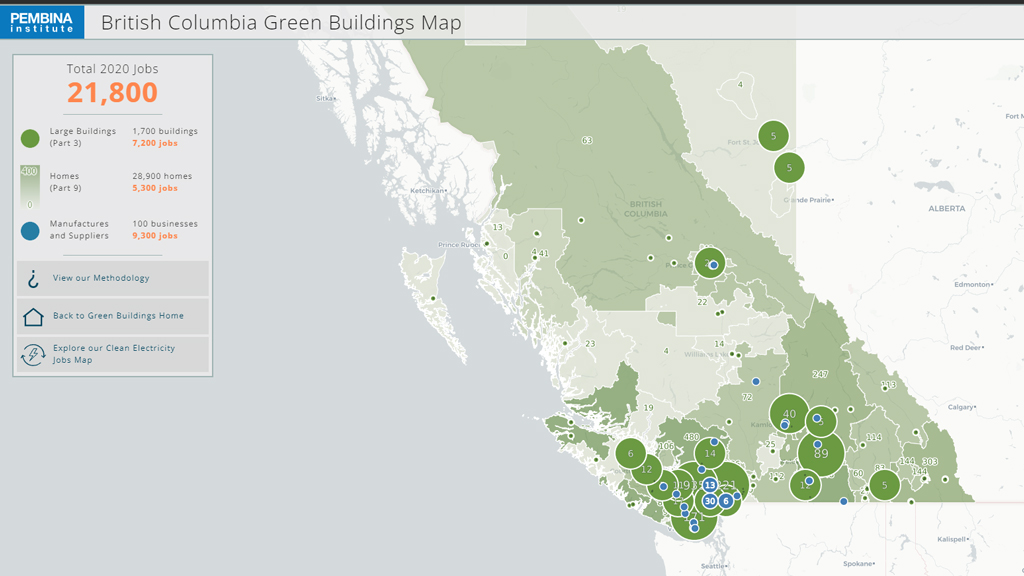Canada needs to embark on an epic retrofit program to hit climate targets, a new report by the Pembina Institute argues, and the massive investment would also create thousands of jobs and accelerate economic recovery.
According to the report, titled Canada’s Renovation Wave, reaching climate targets means eliminating carbon pollution from homes and buildings before 2050 by phasing out onsite combustion of fossil fuels and powering buildings with clean energy.
“Fuel switching to clean electricity (from wind, solar, and hydro) is the most scalable and market ready way to provide low-carbon energy to buildings,” writes the authors, Madi Kennedy and Tom-Pierre Frappé-Sénéclauze. “Fuel-switching should be paired with additional measures to reduce overall energy use, improve air quality and thermal comfort, and increase resilience to extreme weather events and earthquakes.”
The additional investment required nationwide is about $400 billion and would usher in a 20-year wave of retrofits the institute believes would generate huge economic, social and environmental returns.
“Investments in the retrofit economy are very effective means to accelerate economic recovery. This is because the actions needed to decarbonize buildings — manufacturing and installing windows, installing air-source heat pumps, adding insulation, etc. — are labour-intensive, and create jobs where people live: in big cities, suburbs, and small towns,” said researchers. “These are well-paid jobs in the trades, in manufacturing, and in professional services, for small-scale contractors and larger firms.”
The retrofit wave would create up to 200,000 long-lasting well-paid jobs, generate more than $48 billion in economic development each year, and pay for its cost twice over through increased tax revenue. Pembina estimates if it is paired with a rapid decarbonization of electricity grids, these retrofits will allow Canada to decarbonize most of its buildings by 2040.
Pembina’s report also listed a series of recommendations to get the retrofit wave going, including:
- All levels of government should partner up to invest $10 to $15 billion each year over 10 years to enable this renovation wave.
- These investments include $10 billion per year to fund deep retrofits for residential and commercial buildings, with programs covering 50 to 75 per cent of retrofit costs; $2 billion per year to fund no-cost deep retrofits for low-income households and top-up for the renovation of social housing through the National Housing Strategy; $300 million per year in skill development, capacity building and recruitment; $100 million per year to fund market development initiatives to resolve systemic barriers to deep retrofits and facilitate large-scale rollout of new integrated retrofit offerings; and $100 million per year to fund research, development and demonstration of key retrofit technologies.
- Retrofit funding should be disbursed through a small number of large programs, to minimize market confusion and ensure efficacy of public investments. This could include channelling funds through established programs (municipal, provincial, utility).
- Access to federal funds for the renovation wave should be made contingent on provinces committing and implementing regulatory roadmaps for a zero-carbon building sector.
- The federal government should capitalize a loan guarantee program to reduce the risk to private financing of building retrofits and CMHC should support the rollout and harmonization of PACE financing across Canada.
- The federal government should create a vision for a nationwide renovation wave aiming at decarbonizing the vintage stock by 2040.
- The federal government should partner with provinces to align the following regulatory commitments towards a zero-carbon building sector: Carbon intensity limits for new and existing buildings; energy performance standards requiring all heating equipment to have a coefficient of performance greater than 100 per cent sometime between 2025 and 2030; and benchmarking, labelling and public disclosure policies to inform real estate market assessment of performance, comfort, climate risks and carbon risks.
Open-data policies, data quality standards, and data exchange protocols to enable data-driven user-centered decision tools for energy investment and market potential analysis.
Follow the author on Twitter @RussellReports.











Recent Comments